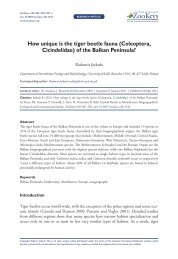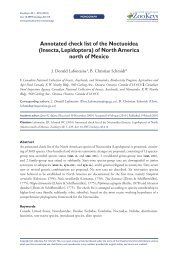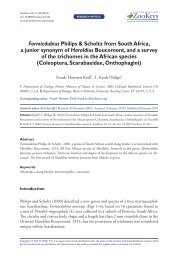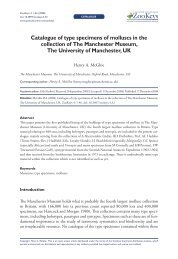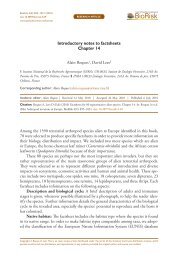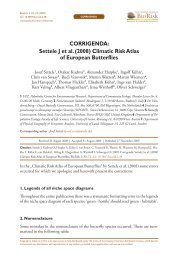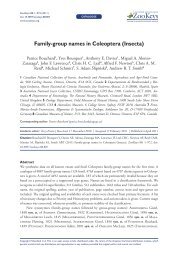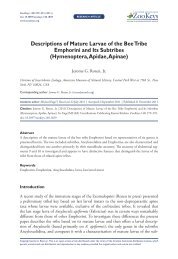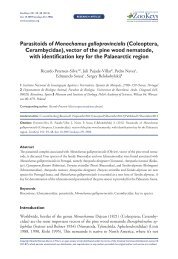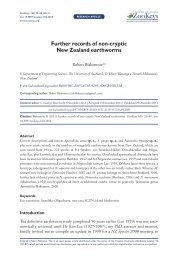A common terminology for the external anatomy of centipedes ...
A common terminology for the external anatomy of centipedes ...
A common terminology for the external anatomy of centipedes ...
Create successful ePaper yourself
Turn your PDF publications into a flip-book with our unique Google optimized e-Paper software.
A <strong>common</strong> <strong>terminology</strong> <strong>for</strong> <strong>the</strong> <strong>external</strong> <strong>anatomy</strong> <strong>of</strong> <strong>centipedes</strong> (Chilopoda) 23Tömösváry’s organ/organs: [Cra, Lit, Scu] hygroreceptor sensory organ at <strong>the</strong> side<strong>of</strong> <strong>the</strong> head. Fig. 5. Syn.: organ/organs <strong>of</strong> Tömösváry, postantennal organ/organs,Tömösváry organ/organs(cephalic) paramedian suture/sutures: [Sco] one <strong>of</strong> <strong>the</strong> paired paramedian sutureson <strong>the</strong> cephalic plate. Fig. 6(cephalic) paramedian sulcus/sulci: [Geo, Lit] one <strong>of</strong> <strong>the</strong> paired paramedian sulcion <strong>the</strong> posterior part <strong>of</strong> <strong>the</strong> cephalic plate. Fig. 4. Syn.: paired posterior depression/depressions.(cephalic) marginal ridge: [Lit, Sco] narrow ridge along <strong>the</strong> lateral and posteriormargins <strong>of</strong> <strong>the</strong> dorsal side <strong>of</strong> <strong>the</strong> cephalic capsule. Fig. 1. Crabill 1961a: 131;Lewis et al. 2005: 7. Syn.: limbus, marginal bulge, marginal rim(cephalic) marginal sulcus/sulci: [Lit, Sco] sulcus between <strong>the</strong> marginal ridge and<strong>the</strong> remaining part <strong>of</strong> <strong>the</strong> dorsal side <strong>of</strong> <strong>the</strong> cephalic capsule. Fig. 1lateral marginal interruption/interruptions (<strong>of</strong> cephalic plate): [Lit] notch on <strong>the</strong>lateral margins <strong>of</strong> <strong>the</strong> cephalic plate. Eason 1964: 179. Syn.: disjuncture/disjunctures<strong>of</strong> limbus, lateral termination/terminations <strong>of</strong> marginal ridge(cephalic) basal plate/plates: [Sco] one <strong>of</strong> <strong>the</strong> paired sclerites at <strong>the</strong> posterior corners<strong>of</strong> <strong>the</strong> cephalic plate. Fig. 6cephalic pleurite/pleurites: [Cra, Dev, Geo, Lit, Sco] one <strong>of</strong> <strong>the</strong> pleurites lateral to<strong>the</strong> clypeolabrum. Fig. 7. Syn.: bucca/buccae, cephalic pleura/pleurae, cephalicpleuron/pleuratransverse suture/sutures (<strong>of</strong> cephalic pleurite): [Geo] transverse suture on <strong>the</strong> cephalicpleurite. Fig. 7. Crabill 1960b: 189. Syn.: buccal suture/sutures, transbuccalsuture/suturesstilus/stili: [Geo] sclerotised ridge on <strong>the</strong> mesal margin <strong>of</strong> <strong>the</strong> cephalic pleurite.Fig. 8. Crabill 1959a: 192; 1964a: 168; 1970: 235. Syn.: buccal margin/marginsanterior incision/incisions (<strong>of</strong> stilus): [Geo] notch on <strong>the</strong> mesal side <strong>of</strong> <strong>the</strong> stilus.Fig. 8. Crabill 1959a: 192spiculum/spicula: [Geo] sclerotised, pointed projection on <strong>the</strong> anterior part <strong>of</strong> <strong>the</strong>cephalic pleurite. Fig. 9. Crabill 1959a: 192; 1964a: 168; 1970: 236maxillary complex: whole <strong>of</strong> first and second maxillaeantennaantenna/antennae: one <strong>of</strong> <strong>the</strong> paired most anterior appendages on <strong>the</strong> head. Fig. 1(antennal) article/articles: one <strong>of</strong> <strong>the</strong> rigid sectors along <strong>the</strong> antenna. Fig. 1. Syn.:(antennal) annulus/annuli, (antennal) joint/joints, (antennal) segment/segments,antennomere/antennomeresscape/scapes: [Scu] set <strong>of</strong> <strong>the</strong> two most basal antennal articles. Fig. 10(antennal) annulation/annulations: [Scu] short antennal article. Fig. 11. Syn.: (antennal)article/articles
A <strong>common</strong> <strong>terminology</strong> <strong>for</strong> <strong>the</strong> <strong>external</strong> <strong>anatomy</strong> <strong>of</strong> <strong>centipedes</strong> (Chilopoda) 25flagellum/flagella: [Scu] one <strong>of</strong> <strong>the</strong> sections along <strong>the</strong> antenna composed <strong>of</strong> annulations.Figs 10–11. Syn.: dupl<strong>of</strong>lagellum/dupl<strong>of</strong>lagella(antennal) node/nodes: [Scu] elongate antennal article between two flagella along<strong>the</strong> antenna. Fig. 11first flagellum/flagella: [Scu] <strong>the</strong> most basal flagellum along <strong>the</strong> antenna. Fig. 10. Syn.:flagellum/flagella primum/prima, first division/divisions <strong>of</strong> antenna/antennaesecond flagellum/flagella: [Scu] <strong>the</strong> second flagellum along <strong>the</strong> antenna. Fig. 11.Syn.: flagellum/flagella secundum/secunda, second division/divisions <strong>of</strong> antenna/antennaethird flagellum/flagella: [Scu] <strong>the</strong> third flagellum along <strong>the</strong> antenna. Fig. 11. Syn.:flagellum/flagella tertium/tertia, third division/divisions <strong>of</strong> antenna/antennaeshaft organ/organs: [Scu] sensory organ on <strong>the</strong> first antennal articleclypeus and labrumclypeolabrum: antero-ventral part <strong>of</strong> <strong>the</strong> cephalic capsule, posterior to <strong>the</strong> antennaeand between <strong>the</strong> cephalic pleurites. Fig. 7clypeus: sclerite on <strong>the</strong> antero-ventral part <strong>of</strong> <strong>the</strong> cephalic capsule, to <strong>the</strong> exclusion<strong>of</strong> <strong>the</strong> labrum. Fig. 12paraclypeal suture/sutures: one <strong>of</strong> <strong>the</strong> lateral margins <strong>of</strong> <strong>the</strong> clypeus. Fig. 7. Crabill1959a: 192; 1959b: 173; 1960b: 189. Syn.: clypeal suture/suturesscute/scutes: area on <strong>the</strong> cuticle, corresponding to <strong>the</strong> <strong>external</strong> face <strong>of</strong> a single epi<strong>the</strong>lialcell. Fig. 7. Syn.: cuticular polygon/polygons(clypeal) areolate part: [Geo] anterior part <strong>of</strong> <strong>the</strong> clypeus that is evidently areolate.Fig. 9. Syn.: areolate clypeusplagula/plagulae: [Geo] one <strong>of</strong> <strong>the</strong> non-areolate areas on <strong>the</strong> posterior part <strong>of</strong> <strong>the</strong>clypeus. Fig. 9. Crabill 1959a: 192; 1959b: 173; 1964a: 168; 1970: 235. Syn.:(clypeal or prelabral) consolidated area/areas, (clypeal or prelabral) non-areolatefield/fields, (clypeal or prelabral) non-areolate part/parts, posterior clypeusmid-longitudinal areolate strip: [Geo] mid-longitudinal areolate band separatingtwo paired plagulae. Fig. 9. Syn.: mid-longitudinal areolate stripeclypeal insula/insulae: [Geo] non-areolate area inside <strong>the</strong> areolate part <strong>of</strong> <strong>the</strong> clypeus.Fig. 9clypeal area/areas: [Geo] small, subcircular, median area on <strong>the</strong> areolate part <strong>of</strong> <strong>the</strong>clypeus, with distinctly finer or indistinct areolation. Fig. 7. Syn.: anteroclypealarea/areas, clypeal spot/spots, (clypeal or anterocentral) fenestra/fenestraeclypeolabral suture: suture between clypeus and labrum. Fig. 12labrum: posterior part <strong>of</strong> <strong>the</strong> clypeolabrum, sometimes delimited from <strong>the</strong> clypeusby a suture. Fig. 12. Syn.: upper lip(labral) mid-piece: median sclerite <strong>of</strong> <strong>the</strong> labrum. Fig. 13. Syn.: (labral) medianpiece, (labral) middle piece
26Lucio Bonato et al. / ZooKeys 69: 17–51 (2010)(labral) intermediate part: [Geo] median part <strong>of</strong> <strong>the</strong> labrum, when not a scleritedistinct from <strong>the</strong> lateral parts. Fig. 14. Syn.: median labromere, (labral) medianpiece, (labral) middle piece, (labral) middle portion, (labral) mid-piece(labral) mid-piece tooth: sclerotised tooth on <strong>the</strong> labral mid-piece. Fig. 13(labral) side-piece/side-pieces: one <strong>of</strong> <strong>the</strong> paired lateral sclerites <strong>of</strong> <strong>the</strong> labrum.Fig. 13. Syn.: (labral) lateral piece/pieces, (labral) lateral portion/portions(labral) lateral part/parts: [Geo] one <strong>of</strong> <strong>the</strong> paired lateral parts <strong>of</strong> <strong>the</strong> labrum, whennot sclerites distinct from <strong>the</strong> intermediate part. Fig. 14. Syn.: (labral) lateralportion/portions, (labral) side-piece/side-pieces(labral) ala/alae: [Geo] one <strong>of</strong> <strong>the</strong> two sclerites composing <strong>the</strong> labral side-piece. Fig. 8(labral) anterior ala/alae: [Geo] <strong>the</strong> anterior <strong>of</strong> <strong>the</strong> two sclerites composing <strong>the</strong> labralside-piece. Fig. 8(labral) posterior ala/alae: [Geo] <strong>the</strong> posterior <strong>of</strong> <strong>the</strong> two sclerites composing <strong>the</strong>labral side-piece. Fig. 8(labral) transverse thickened line/lines: [Geo] sclerotised ridge between <strong>the</strong> anteriorand posterior ala <strong>of</strong> <strong>the</strong> labral side-piece. Fig. 8(labral) median arc: [Geo] concave posterior margin <strong>of</strong> <strong>the</strong> labral intermediate part.Fig. 12. Syn.: labral arch(labral) bristle/bristles: hair-like, sometimes branching, projection along <strong>the</strong> posteriormargin <strong>of</strong> <strong>the</strong> labrum. Fig. 14. Syn.: (labral) branching bristle/bristles, (labral)filament/filaments, (labral) (branched) fimbria/fimbriae, (labral) hair/hairs(labral) denticle/denticles: [Geo] subtriangular, flat projection along <strong>the</strong> posteriormargin <strong>of</strong> <strong>the</strong> labrum. Fig. 12. Syn.: (labral) tooth/teeth(labral) tubercle/tubercles: [Geo] subconical, stout projection along <strong>the</strong> posteriormargin <strong>of</strong> <strong>the</strong> labrum. Fig. 14. Syn.: (labral) tooth/teethparalabial sclerite/sclerites: [Lit, Sco] one <strong>of</strong> <strong>the</strong> paired sclerites posterior to <strong>the</strong>clypeus and lateral to <strong>the</strong> labral side-pieces. Fig. 13. Syn.: coclypeus/coclypeitentorium/tentoria: Y-shaped sclerite whose three limbs are attached to <strong>the</strong> labrallateral parts, <strong>the</strong> cephalic pleurite, and <strong>the</strong> mandibular condyle, respectively.Fig. 13. Syn.: (labral or mandibular) fulcrum/fulcra, (labral or labial) fultura/fulturae, tentorial complex/complexesmandiblemandible/mandibles: one appendage <strong>of</strong> <strong>the</strong> first pair <strong>of</strong> <strong>the</strong> mouth-parts. Fig. 13mandibular condyle/condyles: condyle <strong>of</strong> <strong>the</strong> mandible serving <strong>the</strong> articulationwith <strong>the</strong> tentorium. Fig. 15gnathal edge/edges: distal margin <strong>of</strong> <strong>the</strong> mandible. Fig. 16. Syn.: apical ridge/ridges,gnathal lobe/lobes, molar edge/edgesmanubrium/manubria: slender projection <strong>of</strong> <strong>the</strong> mandible opposite to <strong>the</strong> gnathaledge with respect to <strong>the</strong> mandibular condyle. Fig. 16. Crabill 1960a: 15. Syn.:shank/shanks
A <strong>common</strong> <strong>terminology</strong> <strong>for</strong> <strong>the</strong> <strong>external</strong> <strong>anatomy</strong> <strong>of</strong> <strong>centipedes</strong> (Chilopoda) 27(mandibular) trunk/trunks: main part <strong>of</strong> <strong>the</strong> mandible, to <strong>the</strong> exclusion <strong>of</strong> <strong>the</strong> manubriumand <strong>the</strong> gnathal edge. Fig. 15. Syn.: (mandibular) body/bodies, (mandibular)corpus/corpora, (mandibular) shaft/shafts(mandibular) cruci<strong>for</strong>m suture/sutures: [Sco] pair <strong>of</strong> crossed sutures on <strong>the</strong> mandibulartrunk. Fig. 16. Syn.: cruci<strong>for</strong>m fissure/fissureslamina/laminae manubrii: [Sco] part <strong>of</strong> <strong>the</strong> mandible between manubrium andcruci<strong>for</strong>m suture. Fig. 16. Crabill 1960a: 15lamina/laminae triangularis/triangulares: [Sco] part <strong>of</strong> <strong>the</strong> mandible between <strong>the</strong>lamina manubrii and <strong>the</strong> lamina dentifera, opposite to <strong>the</strong> lamina condyliferawith respect to <strong>the</strong> cruci<strong>for</strong>m suture. Fig. 16. Crabill 1960a: 15lamina/laminae dentifera/dentiferae: [Sco] part <strong>of</strong> <strong>the</strong> mandible between apical ridgeand cruci<strong>for</strong>m suture. Fig. 16. Crabill 1960a: 15lamina/laminae condylifera/condyliferae: [Sco] part <strong>of</strong> <strong>the</strong> mandible between <strong>the</strong>lamina manubrii and <strong>the</strong> lamina dentifera, including <strong>the</strong> mandibular condyleand opposite to <strong>the</strong> lamina triangularis with respect to <strong>the</strong> cruci<strong>for</strong>m suture.Fig. 16. Crabill 1960a: 15molar plate/plates: [Scu] sclerotised, flat area on <strong>the</strong> gnathal edgepulvillus/pulvilli: array <strong>of</strong> dense short scales on <strong>the</strong> dorsal end <strong>of</strong> <strong>the</strong> mandibulargnathal edge. Fig. 15. Syn.: furry pad/pads, Haarpolster(mandibular) acicula/aciculae: one <strong>of</strong> <strong>the</strong> slender long projections on <strong>the</strong> ventralend <strong>of</strong> <strong>the</strong> mandibular gnathal edge. Fig. 15. Edgecombe 2001: 203. Syn.: sicklebristle/bristles, sickle-shaped bristle/bristlespinnule/pinnules (<strong>of</strong> acicula): one <strong>of</strong> <strong>the</strong> branches <strong>of</strong> a mandibular acicula(mandibular) branching bristle/bristles: [Lit] hair-like, branching projection fringing<strong>the</strong> mandibular teeth and aciculae(mandibular) accessory denticle/denticles: [Lit, Sco] one <strong>of</strong> <strong>the</strong> denticles arrangedin rows on <strong>the</strong> mandibular teeth(mandibular) lamella/lamellae: one <strong>of</strong> <strong>the</strong> flat projections on <strong>the</strong> gnathal edge <strong>of</strong> <strong>the</strong>mandible. Fig. 17. Syn.: (mandibular) lamina/laminae(mandibular) dentate lamella/lamellae: mandibular lamella bearing teeth. Fig. 17.Syn.: dentate lamina/laminae, dentate plate/plates, lamella/lamellae dentata/dentatae(mandibular) tooth/teeth: sclerotised, large, subconical, projection on a mandibulardentate lamella. Fig. 15(mandibular) tricuspid tooth/teeth: tooth with three tips on a dentate lamella. Fig. 16(mandibular) block/blocks: one <strong>of</strong> <strong>the</strong> sclerotised distinct parts <strong>of</strong> a dentate lamella,each bearing one or more teeth. Fig. 17(mandibular) pectinate lamella/lamellae: [Geo, Sco] mandibular lamella bearingpoorly sclerotised, subcylindrical, slender projections. Fig. 17. Syn.: pectinatelamina/laminae(mandibular) basal tooth/teeth: [Geo] subconical projection at <strong>the</strong> base <strong>of</strong> <strong>the</strong> firstmandibular lamella
28Lucio Bonato et al. / ZooKeys 69: 17–51 (2010)Figures 17–24. 17 distal part <strong>of</strong> right mandible, posterior, Pectiniunguis ducalis 18 left part <strong>of</strong> maxillarycomplex, ventral, Pectiniunguis ducalis 19 maxillary complex, ventral, Geophilus carpophagus 20 maxillarycomplex, ventral, Mecistocephalus togensis 21 right part <strong>of</strong> maxillary complex, ventral, Lithobius dentatus22 anterior right part <strong>of</strong> maxillary complex, dorsal, Scolopendra oraniensis 23 maxillary complex, ventral,Pectiniunguis ducalis 24 maxillary complex, ventral, Ribautia centralis. Abbreviations: mand., mandibular;max., maxillary.
A <strong>common</strong> <strong>terminology</strong> <strong>for</strong> <strong>the</strong> <strong>external</strong> <strong>anatomy</strong> <strong>of</strong> <strong>centipedes</strong> (Chilopoda) 29fi rst maxillaefi rst maxillae {plural only}: pair <strong>of</strong> appendages and associated basal sclerites between<strong>the</strong> mandibles and <strong>the</strong> second maxillae. Fig. 18. Syn.: first maxilla {singular},maxillae I {plural}(first maxillary) sternite: most basal part <strong>of</strong> <strong>the</strong> coxosternite, associated with <strong>the</strong> firstmaxillae(first maxillary) coxa/coxae: part <strong>of</strong> <strong>the</strong> coxosternite corresponding to a coxa, <strong>of</strong> <strong>the</strong>first maxillae(first maxillary) coxosternite: entire sclerite corresponding to sternite and coxae <strong>of</strong><strong>the</strong> first maxillae. Fig. 19. Syn.: coxae {plural}, coxites {plural}, coxosterna {singular},coxosternum, sternum, syncoxite, syncoxosternum(first maxillary) lateral incision: [Geo] notch on <strong>the</strong> lateral margin <strong>of</strong> <strong>the</strong> first maxillarycoxosternite. Fig. 20. Crabil 1959a: 192(first maxillary) coxal projection/projections: one <strong>of</strong> <strong>the</strong> paired projections on <strong>the</strong>anterior margin <strong>of</strong> <strong>the</strong> first maxillary coxosternite, mesal to <strong>the</strong> telopodites.Fig. 21. Syn.: coxal process/processes, inner branch/branches, inner lobe/lobes,medial lobe/lobes, medial projection/projections(first maxillary) telopodite/telopodites: one <strong>of</strong> <strong>the</strong> paired projections, usually articulatedat <strong>the</strong> base, on <strong>the</strong> anterior margin <strong>of</strong> <strong>the</strong> first maxillary coxosternite, lateralto <strong>the</strong> coxal projections. Fig. 21. Syn.: outer branch/branches, outer lobe/lobes,palp/palps, palpus/palpi(first maxillary) basal article/articles: <strong>the</strong> most basal article <strong>of</strong> <strong>the</strong> first maxillarytelopodite. Fig. 18. Syn.: femoroid/femoroids(first maxillary) distal article/articles: <strong>the</strong> most distal article <strong>of</strong> <strong>the</strong> first maxillarytelopodite. Fig. 18. Syn.: tibio-tarsus/tibio-tarsi(first maxillary) plumose bristle/bristles: [Lit] one <strong>of</strong> <strong>the</strong> fea<strong>the</strong>r-like projections on<strong>the</strong> distal article <strong>of</strong> <strong>the</strong> first maxillary telopodite. Fig. 21(first maxillary) pad/pads: [Sco] array <strong>of</strong> short, dense projections on <strong>the</strong> distal article<strong>of</strong> <strong>the</strong> first maxillary telopodite. Fig. 22(first maxillary) lappet/lappets: [Geo] projection on <strong>the</strong> lateral margin <strong>of</strong> <strong>the</strong> firstmaxillary coxosternite or telopodite. Fig. 19. Syn.: <strong>external</strong> sensory lappet/lappets,(lateral or maxillary) palp/palps, palpal process/processes, (lateral or maxillary)palpus/palpi(first maxillary) coxosternal lappet/lappets: [Geo] lappet on <strong>the</strong> first maxillary coxosternite.Fig. 19. Syn.: coxal palpus/palpi, syncoxal lobe/lobes, syncoxital lappet/lappets(first maxillary) telopodital lappet/lappets: [Geo] lappet on <strong>the</strong> basal article <strong>of</strong> <strong>the</strong>first maxillary telopodite. Fig. 19. Syn.: femural palpus/palpi
30Lucio Bonato et al. / ZooKeys 69: 17–51 (2010)Figures 25–32. 25 left part <strong>of</strong> second maxillae, ventral, Scutigera coleoptrata 26 distal part <strong>of</strong> secondmaxillary right telopodite, dorsal, Lithobius dentatus 27 <strong>for</strong>cipular segment, dorsal, Mecistocephalus togensis28 anterior part <strong>of</strong> body, ventral, Lamyctes emarginatus 29 <strong>for</strong>cipular segment, ventral, Scutigera coleoptrata30 <strong>for</strong>cipular segment, ventral, Clinopodes trebevicensis 31 anterior part <strong>of</strong> <strong>for</strong>cipular segment, ventral,Lithobius dentatus 32 right part <strong>of</strong> <strong>for</strong>cipular segment, ventral, Scolopendra oraniensis. Abbreviations:coxost., coxosternal; <strong>for</strong>c., <strong>for</strong>cipular; max., maxillary; troch., trochanteroprefemur.
32Lucio Bonato et al. / ZooKeys 69: 17–51 (2010)(second maxillary) article/articles 1: [Cra, Geo, Lit, Sco] first article <strong>of</strong> <strong>the</strong> secondmaxillary telopodite. Fig. 23. Lewis et al. 2005: 2, 3. Syn.: basal article/articles,femoroid/femoroids, first article/articles, telomere/telomeres 1(second maxillary) article/articles 2: [Cra, Geo, Lit, Sco] second article <strong>of</strong> <strong>the</strong> secondmaxillary telopodite. Fig. 23. Lewis et al. 2005: 2, 3. Syn.: second article/articles,second joint/joints, telomere/telomeres 2, tibia/tibiae(second maxillary) article/articles 3: [Cra, Geo, Lit, Sco] third article <strong>of</strong> <strong>the</strong> secondmaxillary telopodite. Fig. 23. Lewis et al. 2005: 2, 3. Syn.: apical article/articles,tarsus/tarsi, telomere/telomeres 3, terminal joint/joints, third article/articles, ultimatearticle/articles(second maxillary) plumose seta/setae: [Lit] one <strong>of</strong> <strong>the</strong> setae with apical branches,on article 3 <strong>of</strong> <strong>the</strong> second maxillary telopodite. Fig. 26(second maxillary) dorsal brush/brushes: [Cra, Sco] longitudinal row <strong>of</strong> hairs onarticle 3 <strong>of</strong> <strong>the</strong> second maxillary telopodite. Fig. 22. Lewis et al. 2005: 2, 3. Syn.:palisade/palisades <strong>of</strong> capitate hairs(second maxillary) pretarsus/pretarsi: [Cra, Geo, Lit, Sco] terminal element articulatedto <strong>the</strong> most distal article <strong>of</strong> <strong>the</strong> second maxillary telopodite. Fig. 23. Syn.:praetarsus/praetarsi(second maxillary) claw/claws: [Cra, Geo, Lit, Sco] second maxillary pretarsus inshape <strong>of</strong> a claw. Fig. 26. Syn.: apical claw/claws, pretarsal claw/claws, terminalclaw/clawsdigit/digits (<strong>of</strong> second maxillary claw): [Cra, Lit] one <strong>of</strong> <strong>the</strong> short projections on <strong>the</strong>second maxillary claw. Fig. 26comb/combs (<strong>of</strong> second maxillary claw): [Geo, Sc o] row <strong>of</strong> projections along <strong>the</strong>margin <strong>of</strong> <strong>the</strong> second maxillary claw. Fig. 18. Syn.: comb/combs <strong>of</strong> teethfilament/filaments (<strong>of</strong> second maxillary claw): [Geo, Sco] one <strong>of</strong> <strong>the</strong> slender projections<strong>of</strong> <strong>the</strong> comb <strong>of</strong> <strong>the</strong> second maxillary claw. Fig. 18<strong>for</strong>cipular segment<strong>for</strong>cipular segment: segment bearing <strong>the</strong> <strong>for</strong>cipules. Fig. 2. Syn.: maxillipede segment,prehensorial segment<strong>for</strong>cipular pretergite: [Geo, Sco] short sclerite anterior to <strong>the</strong> <strong>for</strong>cipular tergite.Fig. 2. Syn.: lamina basalis, prebasal plate<strong>for</strong>cipular tergite: main tergite <strong>of</strong> <strong>the</strong> <strong>for</strong>cipular segment. Fig. 2. Syn.: basal plate<strong>for</strong>cipular pleurite/pleurites: lateral sclerite <strong>of</strong> <strong>the</strong> <strong>for</strong>cipular segment. Fig. 2. Syn.:(<strong>for</strong>cipular or maxillipede) pleuron/pleura, (<strong>for</strong>cipular or maxillipede) pleura/pleurae(<strong>for</strong>cipular) scapula/scapulae: [Geo] dorsal ridge <strong>of</strong> <strong>the</strong> <strong>for</strong>cipular pleurite. Fig. 27(<strong>for</strong>cipular) scapular point/points: [Geo] projecting anterior tip <strong>of</strong> <strong>the</strong> <strong>for</strong>cipularscapula. Fig. 27. Crabill 1970: 237. Syn.: scapular projection/projections
A <strong>common</strong> <strong>terminology</strong> <strong>for</strong> <strong>the</strong> <strong>external</strong> <strong>anatomy</strong> <strong>of</strong> <strong>centipedes</strong> (Chilopoda) 33(<strong>for</strong>cipular) collar: [Lit] ventral transversal bridge connecting <strong>the</strong> <strong>for</strong>cipular pleurites.Fig. 28. Syn.: (maxillipede) (pleural) collar(<strong>for</strong>cipular) coxa/coxae: [Scu] one <strong>of</strong> <strong>the</strong> paired sclerites basal to <strong>the</strong> <strong>for</strong>cipules, bearingspine-bristles on <strong>the</strong> anterior margin. Fig. 29. Syn.: (<strong>for</strong>cipular) coxite/coxites(<strong>for</strong>cipular) coxosternite: [Cra, Dev, Geo, Lit, Sco] entire sclerite corresponding tosternite and coxae <strong>of</strong> <strong>the</strong> <strong>for</strong>cipular segment. Fig. 28. Syn.: (maxillipede) coxosternite,(<strong>for</strong>cipular or maxillipede) coxosternum, (prehensorial) pre-sternum,(prehensorial) prosternum(<strong>for</strong>cipular) coxopleural suture/sutures: suture between <strong>the</strong> <strong>for</strong>cipular pleurite and<strong>the</strong> <strong>for</strong>cipular coxae or coxosternite. Fig. 30. Syn.: pleuroprosternal suture/suturescoxosternal condyle/condyles: condyle <strong>of</strong> <strong>the</strong> <strong>for</strong>cipular coxa or coxosternite serving<strong>the</strong> articulation with <strong>the</strong> trochanteroprefemur. Fig. 30. Syn.: (cox<strong>of</strong>emoral orprehensorial) condyle/condyles(coxosternal) cerrus/cerri: [Geo] one <strong>of</strong> <strong>the</strong> paired groups <strong>of</strong> setae on <strong>the</strong> dorsal side<strong>of</strong> <strong>the</strong> <strong>for</strong>cipular coxosternite. Fig. 27. Crabill 1970: 236(coxosternal) condylar process/processes: [Geo] one <strong>of</strong> <strong>the</strong> paired projections <strong>of</strong> <strong>the</strong><strong>for</strong>cipular coxosternite, close to <strong>the</strong> dorsal coxosternal condylesshoulder/shoulders (<strong>of</strong> <strong>for</strong>cipular coxosternite): [Lit] one <strong>of</strong> <strong>the</strong> paired obtuseprojections on <strong>the</strong> anterior margin <strong>of</strong> <strong>the</strong> <strong>for</strong>cipular coxosternite. Fig. 31. Syn.:coxal endite/endites, lateral prosternal prominence/prominences(coxosternal) median diastema: [Cra, Dev, Geo, Lit, Sco] median concavity on <strong>the</strong>anterior margin <strong>of</strong> <strong>the</strong> <strong>for</strong>cipular coxosternite. Fig. 31. Syn.: median interval,median notch, median sinus(coxosternal) tooth/teeth: [Cra, Dev, Lit, Sco] sclerotised, short, subconical projectionon <strong>the</strong> anterior margin <strong>of</strong> <strong>the</strong> <strong>for</strong>cipular coxosternite. Fig. 32. Syn.: (coxosternalor prosternal) (anterior or anterocentral) denticle/denticles, (prosternal or<strong>for</strong>cipular) tooth/teeth, (marginal) tubercle/tubercles(coxosternal) tooth-plate/tooth-plates: [Cra, Sco] one <strong>of</strong> <strong>the</strong> paired sclerotised, flat,teeth-bearing projections on <strong>the</strong> anterior margin <strong>of</strong> <strong>the</strong> <strong>for</strong>cipular coxosternite.Fig. 32. Lewis et al. 2005: 2, 3. Syn.: dental plate/plates, (coxosternal or prosternal)plate/plates, (coxosternal or prosternal) too<strong>the</strong>d anterior process/processes(coxosternal) denticle/denticles: [Geo] one <strong>of</strong> <strong>the</strong> paired small, subconical projectionson <strong>the</strong> anterior margin <strong>of</strong> <strong>the</strong> <strong>for</strong>cipular coxosternite. Fig. 30. Syn.: (coxosternal)tooth/teethporodont/porodonts: [Lit] one <strong>of</strong> <strong>the</strong> paired large setae usually placed lateral to <strong>the</strong><strong>for</strong>cipular coxosternal teeth. Fig. 31. Crabill 1953: 119. Syn.: accessory spine/spines, ectal spine/spines, ectodont/ectodonts, lateral (prosternal) spine/spines,parodontal spine/spines, pseudoporodont/pseudoporodontsporodont node/nodes: [Lit] basal structure from which <strong>the</strong> porodont arises(coxosternal) median cleft: [Lit] mid-longitudinal suture on <strong>the</strong> ventral side <strong>of</strong> <strong>the</strong><strong>for</strong>cipular coxosternite. Fig. 28. Eason 1964: 165.chitin-line/chitin-lines: [Geo] one <strong>of</strong> <strong>the</strong> paired paramedian sclerotised narrow stripeson <strong>the</strong> ventral side <strong>of</strong> <strong>the</strong> <strong>for</strong>cipular coxosternite. Fig. 30. Crabill 1960a: 15.
34Lucio Bonato et al. / ZooKeys 69: 17–51 (2010)F igures 33–40. 33 anterior part <strong>of</strong> trunk, dorsal, Cryptops anomalans 34 intermediate part <strong>of</strong> trunk,dorsal, Lithobius dentatus 35 intermediate part <strong>of</strong> trunk, dorsal, Scutigera coleoptrata 36 intermediate part<strong>of</strong> trunk, left, Himantarium gabrielis 37 intermediate part <strong>of</strong> trunk, ventral, Clinopodes trebevicensis 38intermediate part <strong>of</strong> trunk, ventral, Cryptops parisi 39 intermediate part <strong>of</strong> trunk, ventral, Cryptops punicus40 intermediate part <strong>of</strong> trunk, ventral, Bothriogaster signata.
A <strong>common</strong> <strong>terminology</strong> <strong>for</strong> <strong>the</strong> <strong>external</strong> <strong>anatomy</strong> <strong>of</strong> <strong>centipedes</strong> (Chilopoda) 39transverse sulcus/sulci (<strong>of</strong> sternite): [Sco] transverse sulcus on a sternite. Fig. 39.Lewis et al. 2005: 5median longitudinal sulcus/sulci (<strong>of</strong> sternite): [Sco] mid-longitudinal sulcus on asternite. Fig. 39. Lewis et al. 2005: 5. Syn.: median sulcus/sulci, mid-longitudinalsulcus/sulcicruci<strong>for</strong>m suture/sutures (<strong>of</strong> sternite): [Sco] <strong>the</strong> pair <strong>of</strong> transverse and median longitudinalsulci on a sternite. Fig. 39. Syn.: cross furrow/furrows, cross sulcus/sulci,cruci<strong>for</strong>m impression/impressions, cruci<strong>for</strong>m sulcus/sulcitrigonal suture/sutures (<strong>of</strong> sternite): [Sco] pair <strong>of</strong> crossed sutures on <strong>the</strong> posteriorpart <strong>of</strong> <strong>the</strong> sternite. Lewis et al. 2005: 5endosternite/endosternites: [Geo, Sco] posterior projection <strong>of</strong> a sternite, covered by<strong>the</strong> sternite <strong>of</strong> <strong>the</strong> following segment. Fig. 37. Syn.: metasternite/metasternitescarpophagus peg/pegs: [Geo] median projection on <strong>the</strong> posterior margin <strong>of</strong> a sternite,in <strong>the</strong> carpophagus-structure. Fig. 37 . Crabill 1954: 174. Syn.: paxillus/paxillicarpophagus pit/pits: [Geo] median socket on <strong>the</strong> anterior margin <strong>of</strong> a sternite, in<strong>the</strong> carpophagus-structure. Fig. 37. Crabill 1954: 174. Syn.: carpophagus fossa/fossae, sacculus/sacculi, sternal pit/pitscarpophagus-structure/carpophagus-structures: [Geo] whole <strong>of</strong> a carpophagus pegand <strong>the</strong> associated carpophagus pit. Fig. 37ventral pore/pores: [Geo] glandular pore on <strong>the</strong> ventral side <strong>of</strong> a leg-bearing segment.Fig. 40. Syn.: sternal pore/pores, sternital pore/pores(ventral) pore-field/pore-fields: [Geo] an area <strong>of</strong> clustered pores on <strong>the</strong> ventral side<strong>of</strong> a leg-bearing segment. Fig. 40. Syn.: pore area/areas, pore-group/pore-groups,poriferous area/areas, porigerous area/areassternobothrium/sternobothria: [Geo] median horseshoe-like pit on <strong>the</strong> metasternite.Fig. 40transverse fossa/fossae (<strong>of</strong> sternite): [Geo] transverse, ellipical depression on sometrunk sternites. Fig. 41. Eason 1964: 54fungi<strong>for</strong>m fovea/foveae: [Geo] median T-like pit on <strong>the</strong> metasternitevirguli<strong>for</strong>m fossa/fossae: [Geo] comma-like pit at each <strong>of</strong> <strong>the</strong> anterior corners <strong>of</strong> asternite. Fig. 42. Eason 1964: 284. Syn.: sternal pouch/poucheslateral gutter/gutters (<strong>of</strong> sternite): [Geo] longitudinal groove along <strong>the</strong> lateral margin<strong>of</strong> a sternite. Fig. 42. Eason 1964: 48. Syn.: parasternital cleft/clefts, parasternitalfossa/fossae, parasternital pit/pitsl e gleg/legs: one <strong>of</strong> <strong>the</strong> paired appendages <strong>of</strong> <strong>the</strong> trunk to <strong>the</strong> exclusion <strong>of</strong> <strong>the</strong> <strong>for</strong>cipulesand <strong>the</strong> gonopods. Fig. 41. Syn.: (ambulatory or locomotory or walking) leg/legscursiped/cursipeds: [Lit] a leg <strong>of</strong> <strong>the</strong> pairs 1–13. Crabill 1961a: 132tenaciped/tenacipeds: [Lit] a leg <strong>of</strong> <strong>the</strong> pairs 14–15. Crabill 1961a: 132
40Lucio Bonato et al. / ZooKeys 69: 17–51 (2010)(leg) article/articles: one <strong>of</strong> <strong>the</strong> articulated elements <strong>of</strong> a leg. Fig. 41. Syn.: podomere/podomeres,(leg) segment/segments(leg) coxa/coxae: <strong>the</strong> most basal article <strong>of</strong> a leg. Fig. 38(leg) trochanter/trochanters: small, basalmost article <strong>of</strong> a telopodite. Fig. 38(leg) prefemur/prefemora: second article <strong>of</strong> a telopodite. Fig. 38. Syn.: praefemur/praefemora(leg) femur/femora: third article <strong>of</strong> a telopodite. Fig. 43(leg) tibia/tibiae: fourth article <strong>of</strong> a telopodite. Fig. 43. Syn.: patellotibia/patellotibiae(leg) tarsus/tarsi: fifth article <strong>of</strong> a telopodite, when ultimate. Fig. 43tarsal article/articles: one <strong>of</strong> <strong>the</strong> articles <strong>of</strong> a biarticulated region <strong>of</strong> <strong>the</strong> leg correspondingto <strong>the</strong> tarsus. Syn.: tarsalium/tarsalia, tarsomere/tarsomerestarsus/tarsi 1: <strong>the</strong> basal article <strong>of</strong> two tarsal articles. Fig. 44. Lewis et al. 2005: 2.Syn.: basitarsus/basitarsi, first division/divisions <strong>of</strong> tarsus/tarsi, first tarsal article/articles, first tarsal joint/joints, first tarsal segment/segments, first tarsus/tarsi, Itarsus/tarsi, protarsus/protarsi, proximotarsus/proximotarsi, tarsomere/tarsomeres1, tarsus/tarsi, tarsus/tarsi Itarsus/tarsi 2: <strong>the</strong> distal article <strong>of</strong> two tarsal articles. Fig. 44. Lewis et al. 2005: 2.Syn.: distitarsus/distitarsi, distotarsus/distotarsi, II tarsus/tarsi, metatarsus/metatarsi,pretarsus/pretarsi, second division/divisions <strong>of</strong> tarsus/tarsi, second tarsal article/articles,second tarsal joint/joints, second tarsal segment/segments, secondtarsus/tarsi, tarsomere/tarsomeres 2, tarsus/tarsi II, telotarsus/telotarsi(tarsal) annulation/annulations: [Lit, Sco, Scu] each part <strong>of</strong> a tarsal article, betweentwo contiguous constrictions. Fig. 45. Syn.: annulus/annuli, pseudosegment/pseudosegments, secondary article/articles, tarsale/tarsalia, tarsomere/tarsomerescarina/carinae: [Scu] longitudinal ridge on a leg article. Fig. 46. Edgecombe andGiribet 2006: 509tarsal papilla/papillae: [Scu] relatively short, stout projection with a rounded tip, on<strong>the</strong> ventral side <strong>of</strong> tarsus 2. Fig. 45. Edgecombe and Giribet 2006: 509resilient sole-hair/sole-hairs: [Scu] one <strong>of</strong> <strong>the</strong> paired hairs thickened at <strong>the</strong> base, on<strong>the</strong> ventral side <strong>of</strong> <strong>the</strong> leg, originating near <strong>the</strong> posteromedian margin <strong>of</strong> eachtarsal papilla. Fig. 45. Würmli 1974: 95; Edgecombe and Giribet 2006: 512(leg) spur/spurs: [Lit, Sco] spur on legs. Fig. 44. Syn.: calcar/calcars, (leg or pedal)spine/spines, spini<strong>for</strong>m seta/setaedistal spinose projection/projections (<strong>of</strong> tibia): [Lit] spinous process at <strong>the</strong> distalend <strong>of</strong> <strong>the</strong> tibia <strong>of</strong> a leg. Fig. 43. Syn.: tibial spur/spurspectinal seta/setae: [Lit] one <strong>of</strong> <strong>the</strong> decumbent setae arranged in rows along <strong>the</strong>tarsal articles <strong>of</strong> legs. Fig. 44. Crabill 1958: 262(tarsal) pecten/pectines: [Lit] row <strong>of</strong> pectinal setae. Fig. 44. Crabill 1958: 262pretarsus/pretarsi: apical element articulated at <strong>the</strong> tip <strong>of</strong> a leg. Fig. 43. Lewis et al.2005: 2. Syn.: praetarsus/praetarsi, postarsus/postarsi, posttarsus/posttarsiclaw/claws: pretarsus in shape <strong>of</strong> a claw. Fig. 44. Lewis et al. 2005: 2. Syn.: apicalclaw/claws, end claw/claws, tarsal claw/claws
42Lucio Bonato et al. / ZooKeys 69: 17–51 (2010)Figures 49–56. 49 terminal part <strong>of</strong> trunk, dorsal, Gnathoribautia bonensis 50 ultimate leg-bearing segment,dorsal, Bothriogaster signata 51 terminal part <strong>of</strong> trunk, ventral, female Dicellophilus carniolensis 52terminal part <strong>of</strong> trunk, ventral, Cormocephalus gervaisianus 53 basal part <strong>of</strong> posterior left legs, ventral,Lithobius dentatus 54 terminal part <strong>of</strong> trunk, ventral, male Tuoba sydneyensis 55 basal part <strong>of</strong> ultimate leftlegs, dorsal, Scolopendra oraniensis 56 ultimate right leg, posterior, Cryptops anomalans.
A <strong>common</strong> <strong>terminology</strong> <strong>for</strong> <strong>the</strong> <strong>external</strong> <strong>anatomy</strong> <strong>of</strong> <strong>centipedes</strong> (Chilopoda) 43ultimate leg/legs: one <strong>of</strong> <strong>the</strong> legs <strong>of</strong> <strong>the</strong> ultimate pair. Fig. 49. Syn.: anal leg/legs,caudal leg/legs, end leg/legs, last leg/legs, posterior leg/legs, terminal leg/legscoxopleuron/coxopleura: [Geo, Sco] basal element <strong>of</strong> <strong>the</strong> ultimate leg, correspondingto coxa and pleurites. Fig. 52. Lewis et al. 2005: 2. Syn.: (anal or last) coxa/coxae, coxopleura/coxopleurae, coxopleurite/coxopleurites, (last) pleura/pleurae,pleurocoxa/pleurocoxaecoxopleural process/processes: [Sco] posterior process <strong>of</strong> <strong>the</strong> coxopleuron. Fig. 52.Lewis et al. 2005: 2. Syn.: coxal process/processes, process/processes <strong>of</strong> last coxa/coxae(coxopleural) spine/spines: [Sco] spine on <strong>the</strong> coxopleuron. Fig. 52. Lewis et al.2005: 2, 5. Syn.: (coxopleural) spur/spurs(coxopleural) side spine/spines: [Sco] spine on <strong>the</strong> posterior margin <strong>of</strong> <strong>the</strong> coxopleuronmesal to <strong>the</strong> coxopleural process. Lewis et al. 2005: 5coxal pore/pores: [Cra, Dev, Geo, Lit, Sco] one <strong>of</strong> <strong>the</strong> pores <strong>of</strong> <strong>the</strong> coxal organs onposterior legs. Fig. 51. Syn.: coxopleural pore/pores, pleural pore/poresmacropore/macropores: [Geo] coxal pore that is distinctly larger than <strong>the</strong> o<strong>the</strong>r pores.Fig. 51(coxal) gutter-like depression/depressions: [Lit] depressed area on <strong>the</strong> coxopleuroncontaining <strong>the</strong> openings <strong>of</strong> <strong>the</strong> coxal organs. Fig. 53(coxopleural) pit/pits: [Geo] pit on <strong>the</strong> coxopleuron, containing <strong>the</strong> openings <strong>of</strong> <strong>the</strong>coxal organs. Fig. 54. Crabill 1961a: 133. Syn.: (coxal or coxopleural) crypt/crypts, gland pit/pits, subsurface gland-pit/gland-pits, subsurface pocket/pockets(coxopleural) fossa/fossae: [Geo] longitudinal pouch close to <strong>the</strong> mesal margin <strong>of</strong><strong>the</strong> coxopleuron, containing <strong>the</strong> openings <strong>of</strong> <strong>the</strong> coxal organs. Syn.: (coxopleuralor porigerous) cavity/cavities, (coxopleural or porigerous) fossula/fossulae(coxal) pore-field/pore-fields: [Cra, Dev, Geo, Lit, Sco] part <strong>of</strong> <strong>the</strong> surface <strong>of</strong> <strong>the</strong>coxa or coxopleuron <strong>of</strong> <strong>the</strong> ultimate legs containing <strong>the</strong> coxal pores. Fig. 52.Syn.: (coxal) cribri<strong>for</strong>m area/areas, (coxal) porose area/areasprefemoral spine/spines: [Sco] spine on <strong>the</strong> prefemur <strong>of</strong> ultimate and/or penultimatelegs. Fig. 55. Lewis et al. 2005: 3, 5. Syn.: prefemoral dorsal spur/spurs,prefemoral tooth/teethprefemoral (spinous) process/processes: [Sco] process, usually bearing spines, on<strong>the</strong> prefemur <strong>of</strong> <strong>the</strong> ultimate legs. Lewis et al. 2005: 3, 5, 7. Syn.: distomedialprefemoral tubercle/tubercles(prefemoral) corner spine/spines: [Sco] spine on <strong>the</strong> distal end, on <strong>the</strong> mesal side,<strong>of</strong> <strong>the</strong> prefemur <strong>of</strong> ultimate legs. Lewis et al. 2005: 3, 5. Syn.: (prefemoral) distomedialspine/spinessaw tooth/teeth: [Sco] one <strong>of</strong> <strong>the</strong> bluntly pointed projections arranged in rows on<strong>the</strong> tibia and tarsus 1 <strong>of</strong> ultimate legs. Fig. 56. Lewis et al. 2005: 7. Syn.: (tibialand tarsal) (serrate) comb/combs, mucro/mucrones, saw-like tooth/teethultimate pretarsus/pretarsi: pretarsus <strong>of</strong> <strong>the</strong> ultimate leg. Fig. 56
44Lucio Bonato et al. / ZooKeys 69: 17–51 (2010)Figures 57–64. 57 terminal part <strong>of</strong> trunk, dorsal, Lamyctes emarginatus 58 terminal part <strong>of</strong> trunk, ventral,female Bothriogaster signata 59 postpedal segments, ventral, female Scutigera coleoptrata 60 postpedalsegments, ventral, male Scutigera coleoptrata 61 postpedal segments, ventral, female Lithobius dentatus 62posterior part <strong>of</strong> trunk, ventral, female Geophilus carpophagus 63 postpedal segments, ventral, Scolopendracingulata 64 terminal part <strong>of</strong> trunk, ventral, Craterostigmus tasmanianus. Abbreviations: gon., gonopodal.
A <strong>common</strong> <strong>terminology</strong> <strong>for</strong> <strong>the</strong> <strong>external</strong> <strong>anatomy</strong> <strong>of</strong> <strong>centipedes</strong> (Chilopoda) 45terminal part <strong>of</strong> <strong>the</strong> bodypostpedal segments {plural only}: part <strong>of</strong> <strong>the</strong> trunk posterior to <strong>the</strong> ultimate legbearingsegment. Fig. 57. Syn.: terminal segmentsintermediate tergite: [Lit] tergite posterior to <strong>the</strong> tergite <strong>of</strong> <strong>the</strong> ultimate leg-bearingsegment, corresponding to <strong>the</strong> intermediate sternite. Fig. 57. Eason 1964: 167intermediate sternite: sternite between <strong>the</strong> sternite or metasternite <strong>of</strong> <strong>the</strong> ultimateleg-bearing segment and <strong>the</strong> first genital sternite. Fig. 54intermediate pleurite/pleurites: [Geo] one <strong>of</strong> <strong>the</strong> two pleurites flanking <strong>the</strong> intermediatesternite. Fig. 54first genital tergite: [Lit] tergite posterior to <strong>the</strong> intermediate tergite, correspondingto <strong>the</strong> first genital sternite. Fig. 57first genital sternite: sternite between <strong>the</strong> intermediate sternite and <strong>the</strong> second genitalsternite, usually associated with gonopods. Fig. 54. Syn.: pregenital sternite,sternite <strong>of</strong> first genital segmentfirst genital pleurite/pleurites: one <strong>of</strong> <strong>the</strong> two pleurites flanking <strong>the</strong> first genitalsternite. Fig. 54. Syn.: pleurite <strong>of</strong> first genital segmentfirst genital pleurosternite: entire sclerite corresponding to <strong>the</strong> first genital sterniteand <strong>the</strong> relevant pleurites. Fig. 58first genital coxite/coxites: [Scu] one <strong>of</strong> <strong>the</strong> paired sclerites lateral to <strong>the</strong> first genitalsternite. Fig. 59second genital sternite: sternite posterior to <strong>the</strong> first genital sternite. Fig. 58. Syn.:genital sternite, sternite <strong>of</strong> second genital segmentgonopod/gonopods: one <strong>of</strong> <strong>the</strong> paired appendages usually associated with <strong>the</strong> first or<strong>the</strong> second genital sternite. Fig. 58. Syn.: genital appendage/appendages(genital) style/styles: [Scu] styli<strong>for</strong>m male gonopod. Fig. 60proarthron: [Scu] basal part <strong>of</strong> <strong>the</strong> complex <strong>of</strong> <strong>the</strong> paired female gonopods, composed<strong>of</strong> <strong>the</strong> basal contiguous parts <strong>of</strong> <strong>the</strong> basal articles <strong>of</strong> <strong>the</strong> gonopods. Fig. 59depression/depressions <strong>of</strong> proarthron: [Scu] one <strong>of</strong> <strong>the</strong> paired depressions on <strong>the</strong>proarthron. Fig. 59mesarthron: [Scu] median part <strong>of</strong> <strong>the</strong> complex <strong>of</strong> <strong>the</strong> paired female gonopods, composed<strong>of</strong> <strong>the</strong> distal separated parts <strong>of</strong> <strong>the</strong> basal articles <strong>of</strong> <strong>the</strong> gonopods. Fig. 59sinus <strong>of</strong> mesarthron: [Scu] concave median posterior margin <strong>of</strong> <strong>the</strong> mesarthron.Fig. 59metarthron: [Scu] terminal part <strong>of</strong> <strong>the</strong> complex <strong>of</strong> <strong>the</strong> paired female gonopods.Fig. 59(gonopodal) syntelopodite: [Scu] coalescent pair <strong>of</strong> female gonopod telopodites.Fig. 59(gonopodal) first article/articles: [Cra, Dev, Geo, Lit] basal article <strong>of</strong> <strong>the</strong> gonopod.Fig. 61. Syn.: (gonopodal) basal article/articles, (gonopodal) coxa/coxae, (gonopodal)coxite/coxites, (gonopodal) segment/segments 1(gonopodal) telopodite/telopodites: [Lit] articles <strong>of</strong> <strong>the</strong> gonopod o<strong>the</strong>r than <strong>the</strong> firstarticle. Fig. 61
A <strong>common</strong> <strong>terminology</strong> <strong>for</strong> <strong>the</strong> <strong>external</strong> <strong>anatomy</strong> <strong>of</strong> <strong>centipedes</strong> (Chilopoda) 47Arrangement <strong>of</strong> ocelli in Lithobiomorpha. The number <strong>of</strong> ocelli in differentrows are indicated from <strong>the</strong> most dorsal row to <strong>the</strong> most ventral row, separated bycommas [1+ n 1, n 2, … where 1 is <strong>the</strong> posterior ocellus and n 1, n 2, …are <strong>the</strong> numbers<strong>of</strong> seriate ocelli in <strong>the</strong> rows].Pattern <strong>of</strong> teeth on <strong>the</strong> anterior margin <strong>of</strong> <strong>the</strong> <strong>for</strong>cipular coxosternite in Lithobiomorphaand on <strong>the</strong> tooth-plates in Scolopendromorpha. The number <strong>of</strong> teeth isindicated <strong>for</strong> <strong>the</strong> right and <strong>the</strong> left side, separated by a plus [n right+ n left].Leg-bearing segments and pairs <strong>of</strong> legs. Each leg-bearing segment, or <strong>the</strong> correspondingpair <strong>of</strong> legs, is indicated by an Arabic number, from <strong>the</strong> most anterior one(1) to <strong>the</strong> most posterior one.Tergites and sternites <strong>of</strong> <strong>the</strong> leg-bearing segments. Each tergite and sternite isindicated by T and S respectively (TT and SS <strong>for</strong> multiple tergites and sternites, respectively),followed by an Arabic number, from <strong>the</strong> most anterior ones (T1 and S1)to <strong>the</strong> most posterior ones.Arrangement <strong>of</strong> spurs on <strong>the</strong> legs in Li thobiomorpha (plectrotaxy; Table 3).The position <strong>of</strong> <strong>the</strong> spurs on each article <strong>of</strong> <strong>the</strong> legs is indicated in a tabular <strong>for</strong>m (Table4). Spurs on <strong>the</strong> ventral side are indicated on <strong>the</strong> left part <strong>of</strong> <strong>the</strong> table, those on<strong>the</strong> dorsal side on <strong>the</strong> right part. The pairs <strong>of</strong> legs are indicated by Arabic numbers,from <strong>the</strong> most anterior one (1) to <strong>the</strong> most posterior one (15), as described above.The articles are indicated by <strong>the</strong> following abbreviations: C = coxa, t = trochanter, P =prefemur, F = femur, T = tibia (upper case letter, except <strong>for</strong> trochanter). The position<strong>of</strong> each spur relative to <strong>the</strong> antero-posterior axis is indicated by <strong>the</strong> following abbreviations:a = anterior, m = median, p = posterior (lower case letter). Leg articles withoutTable 4. Example <strong>of</strong> conventional table describing <strong>the</strong> plectrotaxy <strong>of</strong> Lithobius <strong>for</strong>ficatus. See text <strong>for</strong>abbreviations.ventraldorsalC t P F T C t P F T1 - - mp amp am - - mp ap a2 - - mp amp am - - amp ap ap3 - - mp amp am - - amp ap ap4 - - mp amp am - - amp ap ap5 - - mp amp am - - amp ap ap6 - - mp amp am - - amp ap ap7 - - mp amp am - - amp ap ap8 - - mp amp am - - amp ap ap9 - - mp amp am - - amp ap ap10 - - mp amp am - - amp ap ap11 - - mp amp am - - amp ap ap12 - - amp amp am a - amp p ap13 - m amp amp am a - amp p p14 - m amp amp am a - amp p p15 - m amp amp am a - amp p -
48Lucio Bonato et al. / ZooKeys 69: 17–51 (2010)spurs are indicated by a dash. Spurs that could be absent (variation) are indicated inparen<strong>the</strong>ses. Spurs that could be present on one side only are marked by an asterisk.Additional spurs are indicated by <strong>the</strong> abbreviation <strong>of</strong> <strong>the</strong>ir position (a, m, p) typed as asuperscript to <strong>the</strong> corresponding spur (e.g., a a ). Legs with <strong>the</strong> same plectrotaxy in bothventral and dorsal side can be indicated in distinct rows or in a single, <strong>common</strong> line.This convention was first proposed by Ribaut (1921) and introduced in <strong>the</strong> Englishliterature by E.H. Eason and R.E. Crabill (Eason 1951, 1964; Crabill 1953, 1962;Crabill and Lorenzo 1957). Each individual spur is indicated in a text with a <strong>for</strong>mulacomprising <strong>the</strong> following abbreviations: <strong>the</strong> pair <strong>of</strong> legs (1–15), <strong>the</strong> side <strong>of</strong> <strong>the</strong> leg (V =ventral, D = dorsal), <strong>the</strong> position relative to <strong>the</strong> antero-posterior axis (a, m, p), <strong>the</strong> legarticle (C, t, P, F, T) (e.g., 15VaC).Pattern <strong>of</strong> coxal pores on <strong>the</strong> legs in Lithobiomorpha. The number <strong>of</strong> coxalpores is indicated from anterior to posterior legs, without separation between <strong>the</strong> numbers[…n 13n 14n 15].AcknowledgementsResearch supported by <strong>the</strong> University <strong>of</strong> Padova (CPDA081134/08).ReferencesBarber AD (2009) Centipedes. Synopses <strong>of</strong> <strong>the</strong> British Fauna 58. The Linnean Society <strong>of</strong> London,228 pp.Crabill RE (1952) A new cavernicolous Nampabius with a key to its Nor<strong>the</strong>astern Americancongeners (Chilopoda: Lithobiidae). Entomological News 63: 203–206.Crabill RE (1953) A new Zygethopolys from Kentucky and a key to <strong>the</strong> members <strong>of</strong> <strong>the</strong> genus(Chilopoda: Lithobiomorpha: Lithobiidae: Ethopolyinae). Canadian Entomologist 85:119–120.Crabill RE (1954) A conspectus <strong>of</strong> <strong>the</strong> nor<strong>the</strong>astern North American species <strong>of</strong> Geophilus(Chilopoda, Geophilomorpha, Geophilidae). Proceedings <strong>of</strong> <strong>the</strong> Entomological Society <strong>of</strong>Washington 56: 172–188.Crabill RE (1955) On <strong>the</strong> identity <strong>of</strong> <strong>the</strong> Gunthorp types (Chilopoda: Geophilomorpha: Geophilidae).Canadian Entomologist 87: 221–223.Crabill RE (1958) A new Eulithobius with a key to <strong>the</strong> known American species (Chilopoda:Lithobiidae). Journal <strong>of</strong> <strong>the</strong> Washington Academy <strong>of</strong> Sciences 48: 260–262.Crabill RE (1959a) Notes on Mecistocephalus in <strong>the</strong> Americas with a redescription <strong>of</strong> Mecistocephalusguildingii Newport (Chilopoda: Geophilomorpha: Mecistocephalidae). Journal <strong>of</strong><strong>the</strong> Washington Academy <strong>of</strong> Sciences 49: 188–192.Crabill RE (1959b) A new centipede from Okinawa (Chilopoda: Oryidae). Pacific Insects 1:173–176.
A <strong>common</strong> <strong>terminology</strong> <strong>for</strong> <strong>the</strong> <strong>external</strong> <strong>anatomy</strong> <strong>of</strong> <strong>centipedes</strong> (Chilopoda) 49Crabill RE (1960a) A new American genus <strong>of</strong> cryptopid centipede with an annotated key to<strong>the</strong> scolopendromorph genera from America north <strong>of</strong> Mexico. Proceedings <strong>of</strong> <strong>the</strong> UnitedStates National Museum 111: 1–15.Crabill RE (1960b) Ce ntipedes <strong>of</strong> <strong>the</strong> Smithsonian-Bredin Expeditions to <strong>the</strong> West Indies.Proceedings <strong>of</strong> <strong>the</strong> United States National Museum 111: 167–195.Crabill RE (1960c) On <strong>the</strong> identity <strong>of</strong> Stenophilus grenadae (Chamberlin) with a key to <strong>the</strong>known North American congeners (Chilopoda: Geophilomorpha: Himantariidae). Proceedings<strong>of</strong> <strong>the</strong> Biological Society <strong>of</strong> Washington 73: 87–94.Crabill RE (1961a) A new Nuevobius with review <strong>of</strong> <strong>the</strong> genus (Chilopoda: Lithobiomorpha:Lithobiidae). Bulletin <strong>of</strong> <strong>the</strong> Brooklyn Entomological Society 55 (1960): 121–133.Crabill RE (1961b) A new appraisal <strong>of</strong> Afrotaenia (Chilopoda, Geophilomorpha, Schendylidae).Senckenbergiana Biologica 42: 501–505.Crabill RE (1962) Plectrotaxy as a systematic criterion in lithobiomorphic <strong>centipedes</strong> (Chilopoda;Lithobiomorpha). Proceedings <strong>of</strong> <strong>the</strong> United States National Museum 113: 399–412.Crabill RE (1964a) A revised interpretation <strong>of</strong> <strong>the</strong> primitive centipede genus Arrup, with redescription<strong>of</strong> its type-species and list <strong>of</strong> known species. Proceedings <strong>of</strong> <strong>the</strong> Biological Society<strong>of</strong> Washington 77: 161–170.Crabill RE (1964b) On <strong>the</strong> true nature <strong>of</strong> Schizotaenia with notes on contingent matters(Chilopoda: Geophilomorpha: Chilenophilidae). Entomological News 75: 33–42.Crabill RE (1969) Revisionary conspectus <strong>of</strong> Neogeophilidae with thoughts on a phylogeny.Entomological News 80: 38–43.Crabill RE (1970) Concerning mecistocephalid morphology and <strong>the</strong> true identity <strong>of</strong> <strong>the</strong> typespecies<strong>of</strong> Mecistocephalus. Journal <strong>of</strong> Natural History 4: 231–237.Crabill RE, Lorenzo MA (1957) On <strong>the</strong> identity <strong>of</strong> <strong>the</strong> Gunthorp types. Part II and some noteson plectrotaxic criteria (Chilopoda: Lithobiomorpha: Lithobiidae). Canadian Entomologist89: 428–432.Eason EH (1951) Notes on <strong>the</strong> Chilopoda (<strong>centipedes</strong>) <strong>of</strong> Warwickshire and Worcestershire.Annals and Magazine <strong>of</strong> Natural History (12) 4: 257–268.Eason EH (1964) Centipedes <strong>of</strong> <strong>the</strong> British Isles. Warne & Co., London, 294 pp.Edgecombe GD (2001) Revision <strong>of</strong> Paralamyctes (Chilopoda: Lithobiomorpha: Henicopidae),with six new species from Eastern Australia. Record <strong>of</strong> <strong>the</strong> Australian Museum 53: 201–241.Edgecombe GD (2004) Monophyly <strong>of</strong> Lithobiomorpha (Chilopoda): new characters from <strong>the</strong>pretarsal claws. Insects Systematics and Evolution 35: 29–41.Edgecombe GD (2008) Anatomical nomenclature: homology, standardization and datasets.Zootaxa 1950: 87–95.Edgecombe GD, Giribet G (2006) A century later - a total evidence re-evaluation <strong>of</strong> <strong>the</strong> phylogeny<strong>of</strong> scutigeromorph <strong>centipedes</strong> (Myriapoda: Chilopoda). Invertebrate Systematics20: 503–525.Edgecombe GD, Koch M (2008) Phylogeny <strong>of</strong> scolopendromorph <strong>centipedes</strong> (Chilopoda).Morphological analysis featuring characters from <strong>the</strong> peristomatic area. Cladistics 24:872–901.
50Lucio Bonato et al. / ZooKeys 69: 17–51 (2010)Koch M, Edgecombe GD (2006) Peristomatic structures in Scutigeromorpha (Chilopoda): acomparative study, with new characters <strong>for</strong> higher-level systematics. Zoomorphology 125:187–207.Koch M, Edgecombe GD (2008) The peristomatic structures <strong>of</strong> Li thobiomorpha (Myriapoda,Chilopoda): comparative morphology and phylogenetic significance. Journal <strong>of</strong> Morphology269: 153–174.Lewis JGE (1981) The biology <strong>of</strong> <strong>centipedes</strong>. University Press, Cambridge, 476 pp.Lewis JGE, Edgecombe GD, Shelley RM (2005) A proposed standardised <strong>terminology</strong> <strong>for</strong> <strong>the</strong><strong>external</strong> taxonomic characters <strong>of</strong> <strong>the</strong> Scolopendromorpha (Chilopoda). Fragmenta Faunistica48: 1–8.Ribaut H (1921) L’armement des pattes chez les Lithobies. Bulletin de la Société d’HistoireNaturelle de Toulouse 49: 312–319.Sn odgrass RE (1935) Principles <strong>of</strong> insect morphology. McGraw-Hill, New York & London,667 pp.Würmli M (1974) Systematic criteria in <strong>the</strong> Scutigeromorpha. Symposia <strong>of</strong> <strong>the</strong> ZoologicalSociety <strong>of</strong> London 32: 89–98.
A <strong>common</strong> <strong>terminology</strong> <strong>for</strong> <strong>the</strong> <strong>external</strong> <strong>anatomy</strong> <strong>of</strong> <strong>centipedes</strong> (Chilopoda) 51Appendix I.Pre-1981 publications. Selected publications published be<strong>for</strong>e 1981 from which morphologicalterms have been retrieved. File <strong>for</strong>mat: PDF. doi: 10.3897/zookeys.69.737-app.IAppendix II.Analytical index. Alphabetic index <strong>of</strong> morphological terms used <strong>for</strong> Chilopoda in <strong>the</strong>English literature. File <strong>for</strong>mat: PDF. doi: 10.3897/zookeys.69.737-app.II



